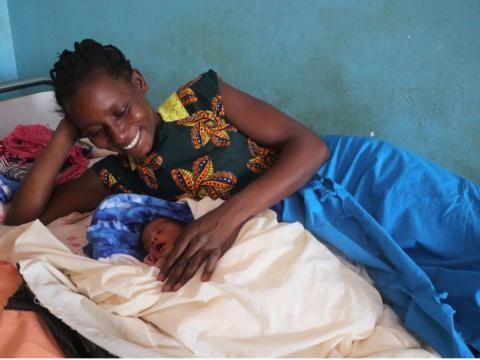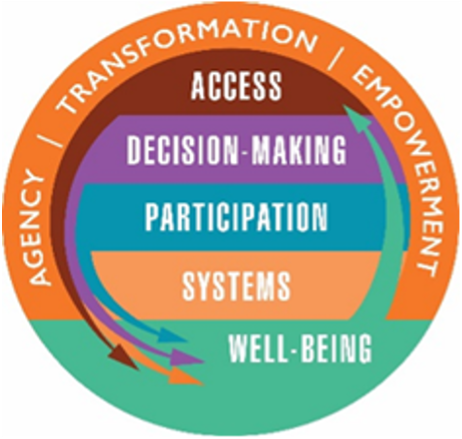Meet Nama: A story about how health awareness campaigns and participation in hospital delivery save lives in South Sudan

Unassisted home deliveries and home deliveries attended by birth attendants contribute to an increased risk of complications for the mother and her baby. In South Sudan’s Western Equatoria State, this is changing through health awareness campaigns and community dialogue sessions. Nama, a 33-year-old mother of nine, shares her story.
Nama delivered six of her nine children at home with a lot of difficulties, most often with bleeding and complications. She recalled a distressing experience when her life was in danger.
“I remember very well, two weeks after the birth of my 6th child, I experienced a lot of pain and bleeding that made me faint. I almost lost my life, but God was faithful. I survived. I experienced a lot of pain in the lower part of my stomach and when I went to the hospital later, I was told that I had infections after delivery. The doctor said it happens when delivery is done in a non-clean environment,” she narrated.
Unassisted home deliveries and home deliveries attended by birth attendants contribute to an increased risk of complications for the mother and her baby. These complications can cause death and lifelong disabilities.[1] Most of these deaths and complications could have been prevented if the expectant mother were attended by a skilled birth attendant. Unfortunately, in South Sudan, many women often deliver at home by themselves or unattended by a skilled birth attendant. This is due to various social, economic, and physical barriers such as a limited number of skilled birth attendance, lack of information, and social norms that prevent them from accessing and participating in skilled childbirth, exposing them to a higher risk of maternal morbidity and mortality.[2]
Home deliveries can be a source of pain, discomfort, and complications that can be life-threatening.
‘’Just like many other women, I delivered at home because of a lack of knowledge on the importance of going to the health facility for skilled delivery by a skilled birth attendant. We were living in darkness, not knowing the importance of healthcare. Another problem is that those days before the health pooled program, there were no qualified health workers at the health facility. Whenever we went to the health facility, we were told that there was no medication and that we would be referred to the private clinic to buy medicine. These are some of the things which discouraged me and other pregnant women from going to the health facility for skilled birth attendance,” Nama explained.
After Nama’s 6th home delivery that almost took her life, she resolved never to have another child because she feared losing her life. However, two years later, she found out that she was pregnant again. She got pregnant because she had not enrolled in family planning and had no information on the importance of child spacing. There was no health awareness conducted in her village to help her understand the benefits of going to the health facility during antenatal care, delivery, and post-natal care. “I was very stressed thinking that I will actually die during childbirth and leave my children,” said Nama.
In the community, most community health workers and health facility management committee members were men. Women did not feel comfortable sharing their challenges with men. They needed fellow women to discuss and ask questions before they decide to access health services openly and freely. Therefore, it was difficult for the male community health workers to explain to the pregnant women in the community the importance of antennal care, skilled delivery, and family planning, among others. This was one of the reasons why home delivery, non-skilled birth attendance, and poor uptake of family planning persisted in the community.
Gender Equality and Social Inclusion
 World Vision prioritizes the Gender Equality and Social Inclusion (GESI) Approach that promotes equal and inclusive access, decision-making, participation, systems, and well-being of the most vulnerable; transforms systems, social norms, and relations to enable the most vulnerable to participate in and benefit equally from development interventions, builds individual and collective agency, resilience, and action and promotes the empowerment and well-being of vulnerable children, their families and communities. The goal is to achieve sustained, transformational change at the individual, household, community, and societal levels so that all persons can enjoy fullness of life.[3]
World Vision prioritizes the Gender Equality and Social Inclusion (GESI) Approach that promotes equal and inclusive access, decision-making, participation, systems, and well-being of the most vulnerable; transforms systems, social norms, and relations to enable the most vulnerable to participate in and benefit equally from development interventions, builds individual and collective agency, resilience, and action and promotes the empowerment and well-being of vulnerable children, their families and communities. The goal is to achieve sustained, transformational change at the individual, household, community, and societal levels so that all persons can enjoy fullness of life.[3]
The Prioritizing GESI in Health Interventions Project in Western Equatoria sought to reach vulnerable groups such as adolescent girls, persons with disabilities, people living in remote areas, those living in poverty, the elderly poor, people living with HIV/AIDS, refugees, and other vulnerable groups. The objectives were to integrate GESI in health interventions, build the capacity of healthcare providers, ensure equal access to and use of health services by the poor, vulnerable, and marginalized population, and improve the health-seeking behaviour of the poor, vulnerable, and marginalized populations so they can obtain health services based on their rights.
The project recruited women as Boma Health Workers (BHWs)[4] and as members of the Health Facility Management Committees (HFMCs). The BHWs and HFMCs members were trained to conduct health awareness campaigns on the various existing health services such as antenatal care, skilled delivery, and family planning, among others.
These campaigns were done through radio, community dialogue sessions, open-air mass campaigns, routine outreach in the community, and routine health discussions at the health facilities. These campaigns aimed at mobilizing women in the community to utilize health services such as antenatal care and skilled birth delivery at the health facility. During the campaigns, pregnant women were advised to go to the health facility for ante-natal care, skilled birth, and enrollment n family planning for better child spacing. These services are important because they prevent childbirth complications and infections that would endanger the life of the mother and her unborn baby. Additionally, the health discussions enlightened men who finally supported their wives to access services because previously, most men did not support their wives to enroll in important lifesaving interventions like family planning. The dialogues also targeted faith-based leaders who were first educated on positive health-seeking behaviors and were later requested to disseminate information to their respective congregations. Additionally, World Vision provided in-kind incentives such as soap, gumboots, and stationery to the HFMCs and BHWs workers to motivate and facilitate their work.
Roy Yona Bambuka, the leader of one of the HFMC said “‘our role as HFMC is to provide an oversight function to the facility – ensuring quality services are always provided and fellow women are mobilised to take up health services. We have achieved a lot because through our efforts, skilled personnel have been recruited and solar power has been installed to ease the delivery of babies at night. “
Yambio State Hospital is among the 12 health facilities supported by World Vision serving a population of 152,257 in addition to all the referrals from the other 6 counties of West Equatoria (Tambura, Nagero, Ezo, Maridi, Ibba, Nzara). The project recruited, trained, and registered skilled midwives, who provided safe deliveries and care.
GESI Impact
Through health awareness campaigns and community dialogue sessions, Nama and other pregnant women got to know the importance of accessing health services like ante-natal care, skilled births, and family planning. The efforts helped to increase the awareness of women on the available services and importance of delivering at the health facility and the danger of home delivery.
Nama said ‘‘the Boma Health Workers came to our community and gave us health education specifically on safe delivery and childcare.’’ Nama and her husband recalled the life-threatening episode in their sixth pregnancy and decided they will participate in hospital delivery by a skilled healthcare worker.
Nama’s husband, Robert, narrated, ‘‘When the labor pains started, I rushed her to Yambio State Hospital. I was not ready to lose my wife, so I kept praying for her and the baby while hoping for a safe delivery just as the healthcare workers said. After 3 hours, Nama successfully gave birth to a healthy baby boy.”
After delivery at the hospital, Nama continues to come to the hospital for routine checkups and baby vaccination. Nama urges women to stop home delivery and know that there is safe delivery at health facilities to avoid child and maternal mortality.
Through this program, Nama’s health and that of her baby improved. Her family is now living a healthier and happier life. They are engaged in productive activities like farming, which provides food and income that she uses to pay for the school fees of her children.
Home deliveries can be life-threatening for a mother and her baby. The Health Pooled Fund Project contributed to a reduction in the incidence of home deliveries and an increase in skilled birth delivery and participation in family planning services. All these contributed to an improvement in the well-being of mothers and their families.
---
The Prioritizing GESI in Health Interventions Project is funded by the Health Pooled Fund, a consolidated fund from the British Government’s Foreign, Commonwealth and Development Office, the Government of Canada, the Swedish International Development and the United States Agency for International Development, European Union and the Global Alliance for Vaccines and Immunization. The development of this success story was part of the GESI Transform Project funded by World Vision U.S.
[1] Vhanice Kwamboka Moriasi, Dr Joyce Bett and Dr Luke Orawo. 2016. Factors Associated with Home Maternal
Deliveries in Rural Areas.” International Journal of Scientific and Research Publications, 6 (8):49-71.
[2] Glob Health Action 2016, 9: 29693 - http://dx.doi.org/10.3402/gha.v9.29693
[3] World Vision GESi Approach and Theory of Change
[4] Boma is the lowest-level administrative division.
Story by: Scovia Charles, World Vision South Sudan Communications Coordinator; Stephen Leonard Epiu, World Vision South Sudan Health, Nutrition, and Water, Sanitation and Hygiene Technical Manager; Leticia Nkonya, PhD., World Vision United States GESI Senior Technical Advisor; and Vicky Poni Mikaya, World Vision South Sudan GESI Coordinator